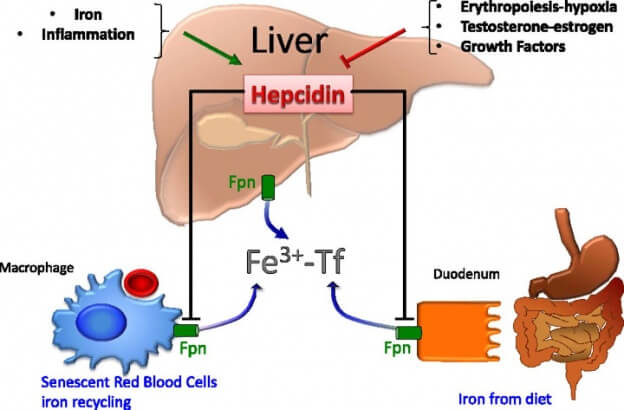Stopping Gout Together › Forums › Help My Gout! The Gout Forum › Hemochromatosis and Secondary Gout
Tagged: Secondary Gout Forum
- This topic has 3 replies, 2 voices, and was last updated 6 years, 10 months ago by
 Keith Taylor.
Keith Taylor.
-
AuthorPosts
-
-
April 13, 2016 at 11:30 pm #1081
Gout Foodie
Participant
My daughter was recently diagnosed as having the genetic iron disorder hemochromatosis. I have been tested but have not yet been diagnosed. I receive the results next week. There is a strong link between hemochromatosis and elevated uric acid levels. There are other significant detrimental health impacts as well, all stemming from elevated levels of iron accumulating in the organs of people with the disorder. Hemochromatosis is a genetic disorder common in people with a Northern European background. I suspect my test will return positive (strangely, I hope it does, because I will then understand the root cause of my gout and will be able to deal with it). I suggest readers of this site suffering from gout consider this issue and have the test. It is a simple blood test and depending on the lab, you will get your results quickly. It is estimated that 10% of the general population have hemochromatosis. I suspect the numbers are much higher among members of this site. Your doctor will devise a way forward with you if you are diagnosed positive.
There is more information here:
Mainous, Arch G., Michele E. Knoll, Charles J. Everett, Eric M. Matheson, Mary M. Hulihan, and Althea M. Grant. “Uric acid as a potential cue to screen for iron overload.” The Journal of the American Board of Family Medicine 24, no. 4 (2011): 415-421.
-
June 1, 2016 at 5:07 am #1210
 Keith TaylorParticipant
Keith TaylorParticipantHey Rod,
Thanks a million for this post.
I’ve been working on a response for a couple of days. Over the years, we’ve had lots of discussions about iron and gout. We’ve seen new research suggest blood donation as a “cure” for excess iron. But, never really looked at causes, beyond trying to reduce iron consumption. I’d never considered the hemochromatosis angle before.
Anyway, I’ve created a place to draw new research and collective experience together. I hope you can add to the knowledge with details of your diagnosis and treatment for hemochromatosis.
We’re always very short of real-world facts. It would be great to see details of relevant blood tests, and there results. What exactly do we test for? What is a safe range? (NOT a statistical normal average!) What are the best treatments?
It could be that your suspicions are right about hemochromatosis among gout sufferers. If that’s true, experience tells me that it will be up to us to do something about it.
To Rod, and everyone else, thank you for any experience and facts about iron related to gout. Please share at Improving Gout & Iron Guidelines.
-
June 2, 2016 at 7:04 am #1215
Gout Foodie
ParticipantHi Keith
My blood test came back that I am heterozygous – I am a carrier only and do not suffer from the condition. Both my daughters are homozygous, but only the older one has elevated iron levels. My son is heterozygous as well. My iron levels were tested concurrently and they were normal. So hemachromatosis is not my problem (Unfortunately?). Nevertheless all my comments above still apply. People should be tested and respond accordingly if they do test positive.
Best,
Rod -
June 8, 2016 at 5:18 am #1225
 Keith TaylorParticipant
Keith TaylorParticipantThanks Rod.
My only concern is that doctors might have the same misunderstanding of “normal” with iron, as they do with uric acid.
Uric acid tests are usually accompanied by a range. It’s often called “Normal” or “Reference” range. Normal is a statistical term that describes where most of the population fit. Since results are based on all tests in the sample period, they include people with medically unsafe uric acid. In other words, Normal = Medically Meaningless Nonsense.
My problem, is lack of specific information about iron blood test results. I don’t understand what is right, and what is wrong. Unlike uric acid, where I know exactly what is a safe level, I don’t understand safe iron levels.
We can do without uric acid, but the same is not true of iron. So, there must be a safe range with lower and upper limits. I also get confused by all the different types of blood test.
Anyway, as I get time, I’ll continue my review of Improving Gout & Iron Guidelines. Hopefully, from that, I can determine the relative importance of different iron tests for gout sufferers. If I can’t establish safe levels, I can at least hope to identify where results suggest further investigation.
-
-
AuthorPosts
The forum ‘Help My Gout! The Gout Forum’ is closed to new topics and replies.

Iron & Inflammation is complicated – and this is without uric acid!
Hemochromatosis and Gout
This discussion covers many aspects of hemochromatosis and gout. So after reading this, you should also read the latest hemochromatosis and gout facts (which includes links to a ferritin and gout article).
Where your doctor determines that hemochromatosis is causing gout, it is possible to cure gout by curing hemochromatosis. So continue with your Secondary Gout Plan.